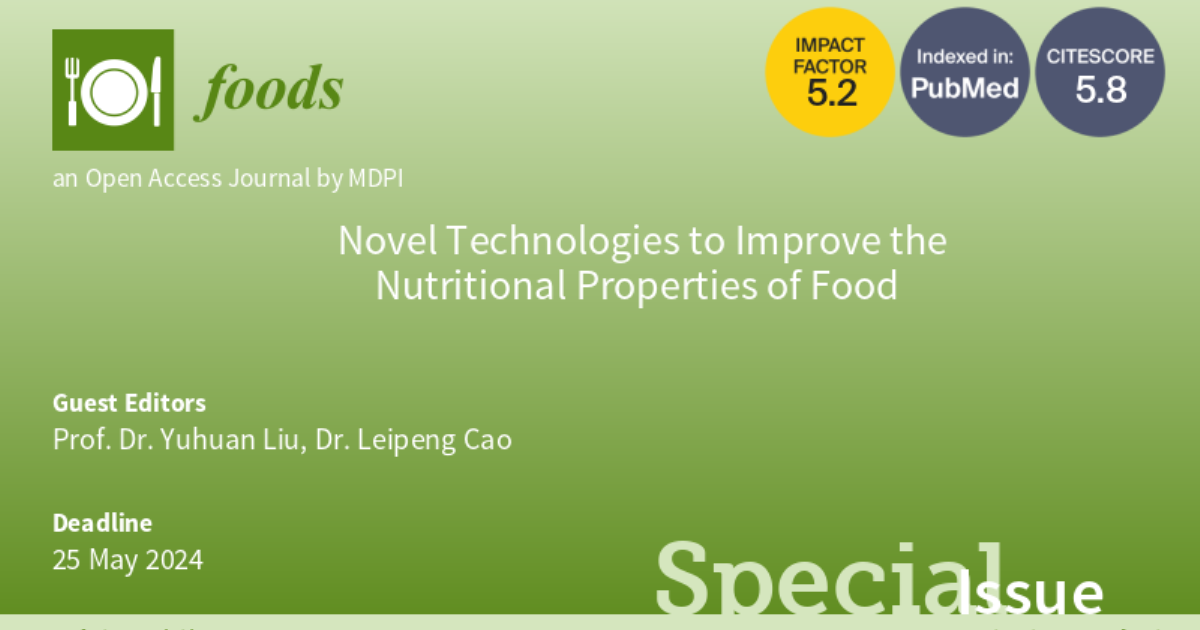Novel Technologies to Improve the Nutritional Properties of Food
A special issue of Foods (ISSN 2304-8158). This special issue belongs to the section "Food Engineering and Technology".
Deadline for manuscript submissions: closed (25 May 2024) | Viewed by 7850

Special Issue Editors
Interests: food processing; biofunctional activity; food fermentation; microalgae food; functional food
Interests: food processing; extraction; biofunctional activity; nutritional properties
Special Issue Information
Dear Colleagues,
With the improvement of consumer's living levels, the nutritions, freshness, and biofunctional activity of food have attracted great attention. However, the texture, flavor and appearance of food are adversely affected by traditional processing (thermal processing, freezing, etc.), which eventually leads to the deterioration of its nutritional compounds (protein, peptide, polysaccharide, fatty acid, etc.) and biofunctional activity. In recent years, in order to overcome the limitations of traditional processing, non-thermal food processing (ultrasonic, cold plasma, pulse electric field, etc.) has begun to flourish, which has improved the appearance and biofunctional activity of food. Therefore, we invite scientists to contribute research on alternative emerging processing technologies for the food industry to improve its nutritional quality and functional activity.
Functional carbohydrates are used in the food and livestock industries because they are beneficial to human and animal health. Therefore, we aim to verify and elaborate on the functions and mechanisms of carbohydrates in order to better develop functional products; one of the hot topics in this Special Issue will be how to adopt gentle processing techniques to obtain functional oligosaccharides with biodiversity from a wide range of food raw materials.
Prof. Dr. Yuhuan Liu
Dr. Leipeng Cao
Guest Editors
Manuscript Submission Information
Manuscripts should be submitted online at www.mdpi.com by registering and logging in to this website. Once you are registered, click here to go to the submission form. Manuscripts can be submitted until the deadline. All submissions that pass pre-check are peer-reviewed. Accepted papers will be published continuously in the journal (as soon as accepted) and will be listed together on the special issue website. Research articles, review articles as well as short communications are invited. For planned papers, a title and short abstract (about 100 words) can be sent to the Editorial Office for announcement on this website.
Submitted manuscripts should not have been published previously, nor be under consideration for publication elsewhere (except conference proceedings papers). All manuscripts are thoroughly refereed through a single-blind peer-review process. A guide for authors and other relevant information for submission of manuscripts is available on the Instructions for Authors page. Foods is an international peer-reviewed open access semimonthly journal published by MDPI.
Please visit the Instructions for Authors page before submitting a manuscript. The Article Processing Charge (APC) for publication in this open access journal is 2900 CHF (Swiss Francs). Submitted papers should be well formatted and use good English. Authors may use MDPI's English editing service prior to publication or during author revisions.
Keywords
- functional activity
- non-thermal processing
- nutritional quality
- traditional processing
- emerging processing technologies
- microalgae food
- functional oligosaccharides
- biodiversity
- intestinal microbiota







